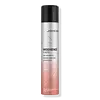What's inside
What's inside
 Key Ingredients
Key Ingredients

No key ingredients
 Benefits
Benefits

 Concerns
Concerns

 Ingredients Side-by-side
Ingredients Side-by-side

Isobutane
Alcohol Denat.
AntimicrobialPropane
Oryza Sativa Extract
AbsorbentDisteardimonium Hectorite
StabilisingDipropylene Glycol
HumectantC12-15 Pareth-12
EmulsifyingHydroxyethylcellulose
Emulsion StabilisingCellulose Gum
Emulsion StabilisingPectin
Emulsion StabilisingPvp
Emulsion StabilisingCetrimonium Chloride
AntimicrobialHydroxycitronellal
PerfumingAlpha-Isomethyl Ionone
PerfumingParfum
MaskingHydrofluorocarbon 152a
Butane
Sd Alcohol 40-B
AstringentOryza Sativa Starch
AbsorbentDisiloxane
Skin ConditioningPunica Granatum Fruit Extract
AntioxidantVaccinium Myrtillus Fruit Extract
Skin ConditioningZeolite
AbsorbentAluminum Starch Octenylsuccinate
AbsorbentDiisopropyl Adipate
EmollientPvp
Emulsion StabilisingDisteardimonium Hectorite
StabilisingWater
Skin ConditioningGlycerin
HumectantMethoxycinnamidopropyl Hydroxysultaine
UV AbsorberMagnesium Stearate
Cosmetic ColorantStearic Acid
CleansingEDTA
Parfum
MaskingSodium Chloride
MaskingBenzoic Acid
MaskingCetrimonium Chloride
AntimicrobialPhenoxyethanol
PreservativeCI 60725
Cosmetic ColorantCI 17200
Cosmetic ColorantButylphenyl Methylpropional
PerfumingAlpha-Isomethyl Ionone
PerfumingBenzyl Salicylate
PerfumingLimonene
PerfumingGeraniol
PerfumingHydroxycitronellal
PerfumingLinalool
PerfumingHydrofluorocarbon 152a, Butane, Sd Alcohol 40-B, Oryza Sativa Starch, Disiloxane, Punica Granatum Fruit Extract, Vaccinium Myrtillus Fruit Extract, Zeolite, Aluminum Starch Octenylsuccinate, Diisopropyl Adipate, Pvp, Disteardimonium Hectorite, Water, Glycerin, Methoxycinnamidopropyl Hydroxysultaine, Magnesium Stearate, Stearic Acid, EDTA, Parfum, Sodium Chloride, Benzoic Acid, Cetrimonium Chloride, Phenoxyethanol, CI 60725, CI 17200, Butylphenyl Methylpropional, Alpha-Isomethyl Ionone, Benzyl Salicylate, Limonene, Geraniol, Hydroxycitronellal, Linalool
Ingredients Explained
These ingredients are found in both products.
Ingredients higher up in an ingredient list are typically present in a larger amount.
Alpha-Isomethyl Ionone is a fragrance. It can be synthetically created or naturally occurring.
The scent of Alpha-Isomethyl Ionone is described as "flowery" but can also be "woody".
Naturally occurring Alpha-Isomethyl Ionone may be found in Saccharomyces cerevisiae, or the yeast used to make wine and bread.
The term 'fragrance' is not regulated in many countries. In many cases, it is up to the brand to define this term. For instance, many brands choose to label themselves as "fragrance-free" because they are not using synthetic fragrances. However, their products may still contain ingredients such as essential oils that are considered a fragrance.
Learn more about Alpha-Isomethyl IononeThis ingredient is a preservative, antimicrobial, and emulsifier. It is often used in cosmetics for its ability to cleanse, condition, and reduce static.
Cetrimonium chloride is a quaternary ammonium salt, meaning it has a water-soluble structure.
Disteardimonium Hectorite comes from the clay mineral named hectorite. It is used to add thickness to a product.
It can also help stabilize a product by helping to disperse other ingredients.
Hectorite is a rare, white clay mineral.
Learn more about Disteardimonium HectoriteHydroxycitronellal is a fragrance created from citronellal. The smell of hydroxycitronellal is often described as "citrus-like" or "melon-like".
Hydroxycitronellal is a known EU allergen and may cause irritation when applied to the skin.
Parfum is a catch-all term for an ingredient or more that is used to give a scent to products.
Also called "fragrance", this ingredient can be a blend of hundreds of chemicals or plant oils. This means every product with "fragrance" or "parfum" in the ingredients list is a different mixture.
For instance, Habanolide is a proprietary trade name for a specific aroma chemical. When used as a fragrance ingredient in cosmetics, most aroma chemicals fall under the broad labeling category of “FRAGRANCE” or “PARFUM” according to EU and US regulations.
The term 'parfum' or 'fragrance' is not regulated in many countries. In many cases, it is up to the brand to define this term.
For instance, many brands choose to label themselves as "fragrance-free" because they are not using synthetic fragrances. However, their products may still contain ingredients such as essential oils that are considered a fragrance by INCI standards.
One example is Calendula flower extract. Calendula is an essential oil that still imparts a scent or 'fragrance'.
Depending on the blend, the ingredients in the mixture can cause allergies and sensitivities on the skin. Some ingredients that are known EU allergens include linalool and citronellol.
Parfum can also be used to mask or cover an unpleasant scent.
The bottom line is: not all fragrances/parfum/ingredients are created equally. If you are worried about fragrances, we recommend taking a closer look at an ingredient. And of course, we always recommend speaking with a professional.
Learn more about ParfumPvp is a water-soluble synthetic polymer and common hairstyling ingredient. It is a film-forming ingredient and used to "hold" specific shapes of hair.
Pvp is less effective in high-humidity. It tends to draw moisture, but this moisture dismantles the structure and "hold".